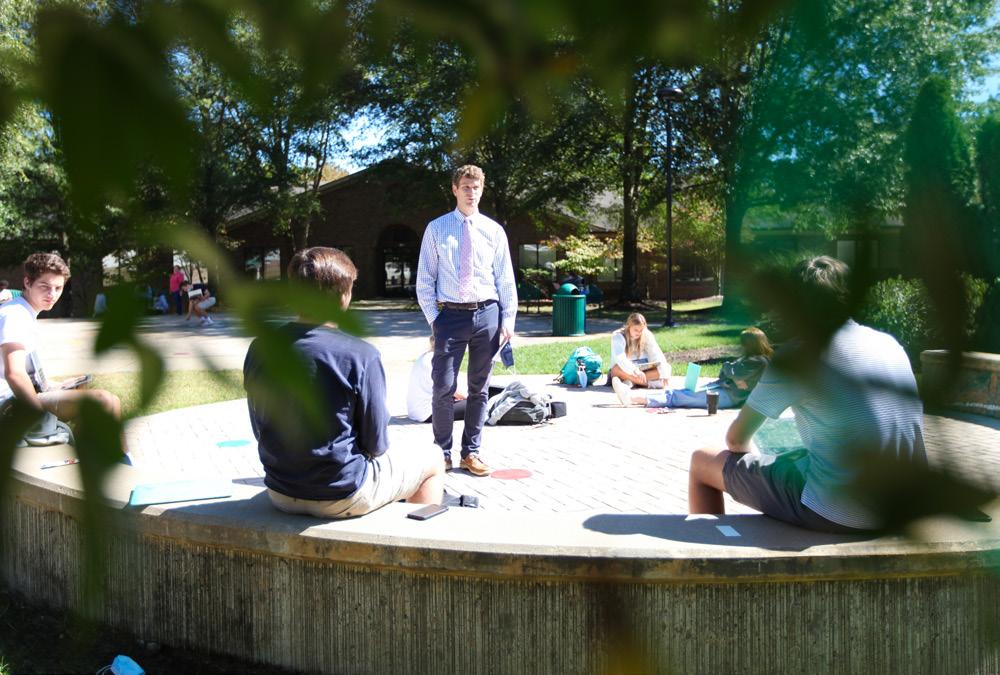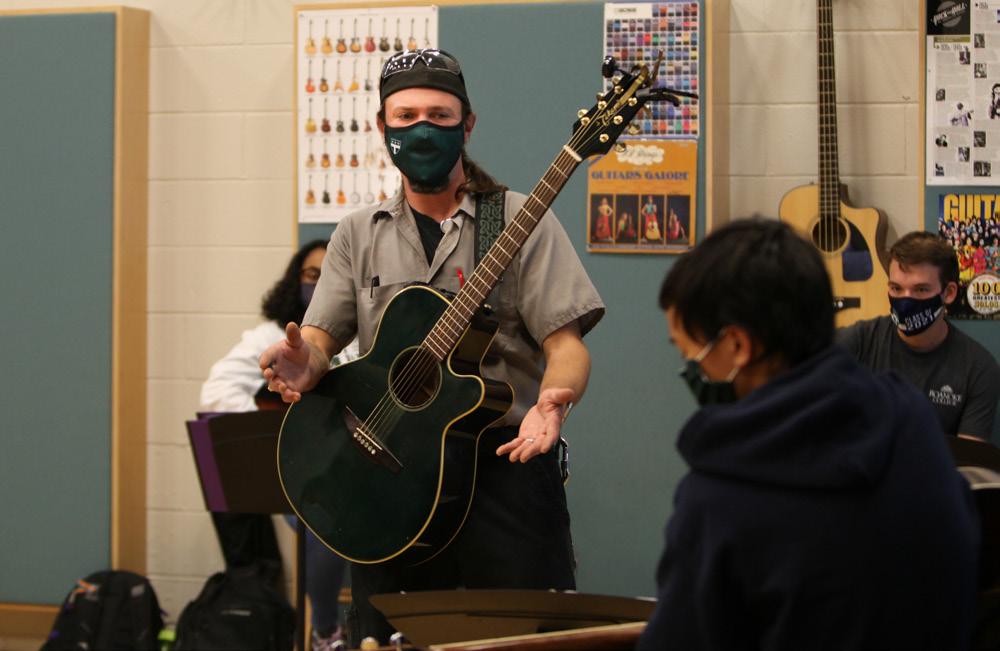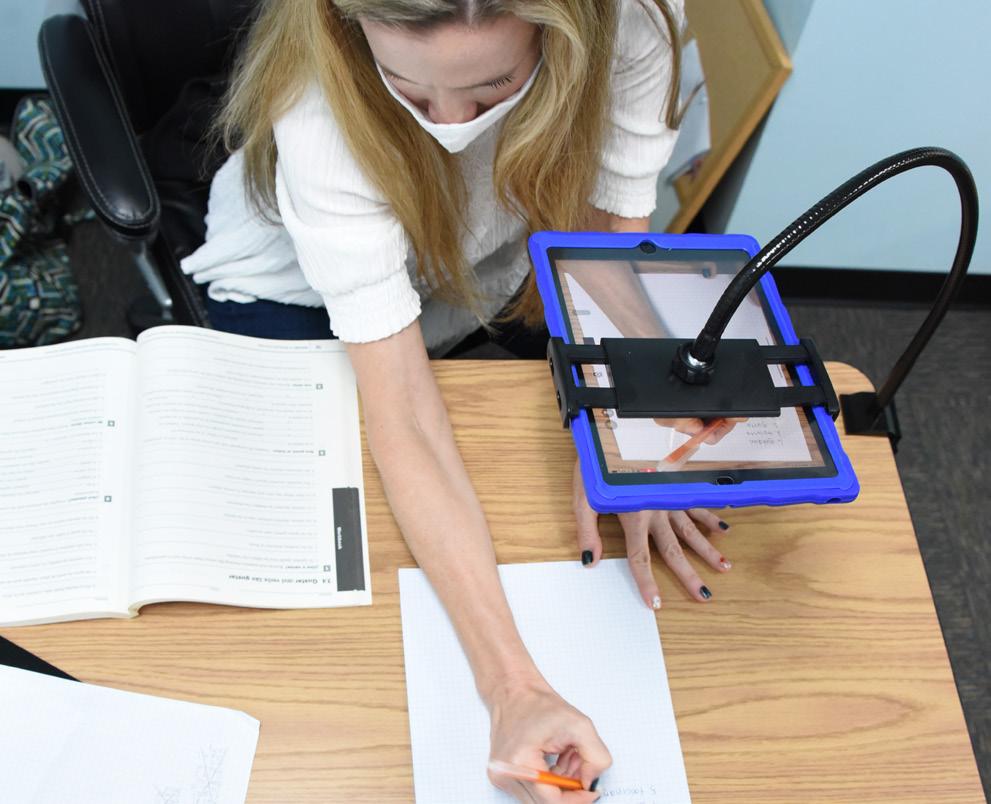
10 minute read
Silver Linings
Teaching and learning in the pandemic year
“M y grandfather was a boxer. He taught me — you’ve got to bob and weave,” says Cheri Bradby, Spanish Since the day Trinity reopened in late August, roughly half of the student body has taken turns coming to campus every two days. teacher. “This has been the kind of year where you have to keep While this parallel model allows for safe distancing in classrooms, bobbing and weaving and just work your way through it and keep hallways and shared spaces, it means that teachers have the added fighting and get to your goal. There are days when tech is great, responsibility of managing two groups of learners — in class and and things go perfectly smoothly, everyone gets all the material, at home — simultaneously. The success of the model has relied and they’re engaged. There are other days when the storm clouds on lots of technology: screens, microphones, video conferencing roll over and no one can figure anything out including me. Those tools, and more. Like so many others, Bradby says she was slightly are the days when you have to bob and weave, roll with it, laugh at pessimistic at first for how the year would turn out. Over the last yourself and keep moving.” half a year, students and teachers have bobbed and weaved; they
Advertisement


adapted, become more efficient, supported one another, and even found a few silver linings among the dark clouds of a pandemic school year.
“We have come so far,” says Associate Head of School Lee Sprague. “I am continually in awe of the creativity and persistence of my colleagues in reimagining what teaching and learning looks like. It has been exciting to see how teachers have adapted to this environment and the renewed gratitude of our students toward their teachers. This year has shown the continued value of personal relationships – something still shining through all of the challenges.”
ENGAGING THE ONLINE LEARNER
“At Trinity, success comes from the relationships you build with students,” says Maria Bartz, who teaches English to 9th graders. This year she found it took longer than usual to build the rapport that normally allows her to give the kind of thorough and honest criticism that student writers need to improve. To help build this trust, she intentionally devoted more class time to ice breaking activities. “I ask fun questions, like ‘what’s your Starbucks order?’ ‘What’s your guilty pleasure TV show?’ or ‘What’s your favorite Disney movie.?’ Slowly, it gets them to open up, and they trust me to get to know them.” An added bonus, she says, has been increased engagement with the remote participants. “Those at home are just as invested in the answers when we do fun questions,” she says.
“My biggest challenge with learning at Trinity this year has been engagement on virtual days,” says Lucy Rowe ’23. “While virtual classes allow students to see and hear the teachers as they teach the in-person class, it is not the same experience that one gets in the classroom. Personally, I have found that it is much harder to focus virtually, especially during lectures, due to the many distractions and an overall different atmosphere at home.”

Rowe appreciates the work of teachers like Bartz and Bradby who have made adjustments to improve the engagement of online students. “For example, in Spanish, we often watch videos, do listening activities, or complete worksheets in class,” she says, “and then both virtual and in class students are asked to participate and answer questions, which fosters engagement while improving speaking skills.”
Bradby says that when she needed to teach from home for a couple of days earlier in the year, she got a taste of how challenging it can be for those remote students to participate. “I had to put my ear up to the computer speaker,” she says. “I often end up repeating what students in class say [so that the kids at home can hear].”
As a guitar teacher, Chris Markunas ’01 recalls facing similar challenges last spring when instruction was all virtual and at the beginning of the new school year. “There’s no replacement for in-person interactions as a musician,” he says. “We could get everyone together on the computer, with their instruments in their hands. But you pretty quickly discovered that you could not all play together at the same time. Even when everyone was playing their parts right, it was just a train wreck.”


Eventually, Markunas developed a strategy that worked: sharing a recorded track of an audio file and playing along with it in real time — while everyone participating remotely kept their microphones muted. “They could hear me keeping in time with the audio that was playing,” he says, “so that whatever latency happened, they could all hear it together and they could play along with that.”
For Bradby, providing frequent opportunities for group discussions in breakout rooms, followed by students reporting back to the larger class, has been an effective model of keeping everyone engaged and prepared. “Everyone gets a participation grade,” she says. “I want to be sure the students at home are getting the same amount of attention. I try to go back and forth between in class and online. The folks online can’t zone out because they could be called on at any time.”
ADAPTING PROJECTS/LESSONS
Like many teachers, Bradby has had to adapt projects that might have traditionally been produced on paper or poster board into online tools like Adobe Spark, PowerPoint or Google Slides. In her Spanish 2 class, the “lo que me gusta’’ project required students to compile a series of selfies, with Spanish captions using verbs they learned in the chapter. The students then shared the presentation with either a recorded voiceover or a live in-class presentation.
For Bartz, presentations have always been a major part of her curriculum, however this year she has found herself adapting the assignments to keep them shorter and more efficient. “Instead of making them do a handful of big presentations, students have done more smaller, shorter presentations. But they are still being held to the same skill set. Are your transitions fluid? Are you referencing your sources? Are you finding info that is intriguing to the audience? I can look for all of that in a two-minute presentation just as much as I can in a 20-minute presentation.”
Few classrooms have seen more adaptation than the band room. “During normal times, there is always a performance looming. There are things you always wish you had more time to work on,” says Brian Rollins, band teacher. This year, however, with performance opportunities severely curtailed, Rollins says he has focused more on individual musicianship and active listening skills. “The essence of being a successful musician is listening, always being a critical listener. That’s a skill that can’t be overstated,” he says. “Every virtual day, part of their assignment is to practice at least 30 minutes working on a variety of skills based on literature or their own personal development.”
When students have collaborated, they have used recording tools and software to combine individual tracks recorded on their own. “What makes this difficult is that you have to record your part perfectly,” says Joe Crews ’21. “Sure you can record as many times as you want but the process is still tricky. This whole process made me become better at expanding my knowledge of an instrument. It helped me play more in time and it helped me avoid mistakes in a song in order to be a better musician. I think I’ve learned how to become a more technical musician.”
LEARNING ABOUT TECHNOLOGY
Crews is hardly alone in feeling a sense of accomplishment for climbing a steep technological learning curve. “At the beginning of the year was a challenge because I was used to writing homework on the board,” says Bradby, who now sings the praises of Google Classroom for tracking assignments. “I did not think I would be able to master the technology, and I have found it not as challenging as I thought it would be.”
While Bartz says she initially benefited from having the majority of her lessons already digitized, she has picked up even more. She thanks colleague Betsy Reid for introducing the English department to “mote,” a web browser extension that allows her to insert voice recordings into the comments of a paper she is grading. “With my comments, they can hear my inflection, hear my excitement about something good.”
In the music department, finding ways to eliminate feedback and latency from playing and teaching music over video conference has led teachers to do a lot of experimenting. All three music teachers,

Markunas, Rollins and Kimberly Ryan, choral and strings teacher, have found external devices (e.g. audio interfaces, microphones and cameras) to improve audio quality and transmission. “There was a lot of creative energy put into figuring out combinations of technologies and approaches to let those at home be a part of what is happening here,” says Markunas. “One of the greatest resources we have is our tech department. They have been consistently available for questions and willing to try new things to help bridge the gap.”
SUPPORTING EACH OTHER
Support is the name of the game for the Academic Resource Center, whose two counselors, Maureen Mauck and Sue Crews, have used a creative combination of the digital and natural world to make themselves available to the students who continue to need them. Throughout the fall, weather permitting, the duo set up a “Mobile ARC Cart” in the plaza outside of the library, allowing for some safely distanced mask free instruction. “They have a digital calendar, can sign up for slots and ensure they will get help. The kids who really need it are getting the help. “They’ve really taken advantage of the technology to help those students,” says Bartz, who also serves as Trinity’s student services coordinator.

“This year has been tough for many students in many different ways,” says Bartz. “For some it took longer to find a groove with virtual learning or hybrid learning. For others, not having a whole sports season was tough. Or not being able to see friends. All the things that make teenagers happy. We’ve certainly seen some struggling academic performance, and social emotional issues, and we have resources to support those students. Mallory Ballard, school counselor, is meeting with more students, because she can do it on RingCentral, which for some students can be less intimidating. She is constantly in touch with students and parents helping them manage all of this.”
Bartz also has high praise for the culture of collaboration and support that has only strengthened during the pandemic. “We’ve all felt like first year teachers again, between planning, grading and figuring out technology. There just wasn’t time for everything,” says Bartz. “We now have more of an open-door policy of sharing tips, popping into each other’s classrooms to check on each other. Emotionally, too, we just keep an eye on each other a little bit more than we normally would.”
LOOKING AHEAD
When asked if she sees herself using some tools when things are back to normal, Bartz is enthusiastic “Absolutely 100%,” she says. “Some of the things I’ve figured out with technology have been amazing.” She says she is glad she was forced to reevaluate every part of her teaching and update some things that might have been overdue. “I’m almost thankful for the year, because I don’t think I would have taken the time to trash something and start from scratch.”
“I’m really hoping the collaboration of our whole school among teachers will continue,” she says. I think it will. I think we all realize that we are all stronger as a faculty together rather than on our own little islands. We realize that we all have the same challenges.”
Lucy Rowe agrees: ”After the pandemic, I have realized that any area in your life is subject to change, so it is important to be ready to quickly adapt to whatever situation I am put in and focus on doing the best I can with what I have instead of dwelling on the negative side of things. I feel like after this year no task or change in my life will seem too daunting because I have learned how to deal with and accept adversity.”










